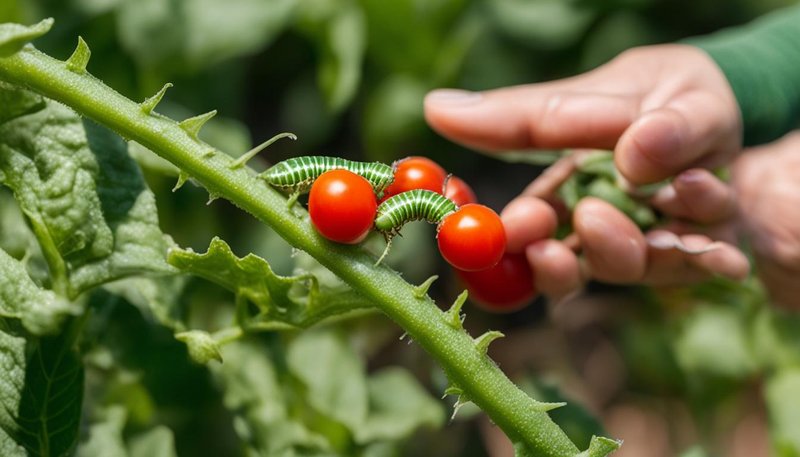
Picture this: you’re enjoying a sunny day in your garden, admiring your tomato plants when suddenly you spot those pesky hornworms. They might be camouflaged in the foliage, but I promise they’re easier to spot than you think. And while you might worry about harming your plants in the process, I’m here to reassure you that picking them off can be done delicately, without causing any distress to your precious greens.
Let me walk you through the ins and outs of handpicking hornworms—no broken branches or wilted leaves in sight!
Understanding Hornworms: What They Are and Why They Matter
Hornworms are the larval stage of the five-spotted hawk moth. They’re lightning-fast when it comes to munching on leaves and can quickly turn your lush garden into a buffet. These green caterpillars can grow up to 4 inches long, and they’re easy to identify thanks to their horn-like protrusions on their backside.
You might be wondering why they matter so much. Well, besides their rapid growth rate, they can cause significant damage to tomato, pepper, and eggplant plants. If left unchecked, a few plants can turn into a full-fledged invasion. Think of them like tiny lawnmowers on steroids—one moment they’re cute little caterpillars, and the next, they’re leaving nothing but stems behind.
Fortunately, handpicking them is an effective and eco-friendly way to control their population. It requires a bit of diligence but can save your plants and keep your garden healthy.
When Is the Best Time to Look for Hornworms?
Timing is everything, especially when it comes to hunting hornworms. They’re **most active** at night and early morning, which ironically makes the evening a great time to go on a little pest patrol. Think of it as a nighttime adventure in your garden!
However, these worms can also be spotted during the day. Look for them on the undersides of leaves, hidden in the shadows. The key is to be patient and observant. You might even find it helpful to take a small flashlight if you’re looking during low-light conditions.
By regularly checking your plants, you can catch hornworms before they balloon into larger problems. It’s always better to act early—just like addressing a small leak before it turns into a major plumbing issue!
How to Identify Hornworms Among Your Plants
Identifying hornworms is surprisingly straightforward once you get the hang of it. They typically blend in perfectly with the green leaves, so your first task is to **look closely at your plants**. Here are some pointers to make things easier:
- **Check the color:** Hornworms are usually a bright green, but they can sometimes have lighter markings or a faint stripe.
- **Look for damage:** Leaves with holes or signs of significant chewing are a clear indicator. If a plant looks like it’s been bitten into, it’s worth investigating.
- **Use your hands:** Gently touch the leaves and branches; if something feels a bit more substantial than just a leaf, it could be a hornworm!
The more you familiarize yourself with what these caterpillars look like, the easier it will be to spot them. It’s a bit like learning to recognize a friend in a crowd—you’ll get better at it with practice!
How to Safely Handpick Hornworms
Now that you know how to find them, let’s talk about the actual handpicking process. This is where the real fun begins! You’ll want to approach this task with care to avoid damaging your plants, and here’s how:
1. **Wear gloves:** While hornworms aren’t harmful to touch, wearing gloves can help protect your hands and keep any toxins or residues off your skin.
2. **Gently grasp the hornworm:** Pinch it lightly between your fingers. Remember, they can sometimes be pretty wiggly! Try to grab them without squeezing too hard to prevent crushing your plants.
3. **Remove them carefully:** Once you’ve got a good grip, gently pull them away from the plant. If you notice any leaves or stems stuck to them, take your time to free them without tearing the plant.
4. **Dispose of them wisely:** If you have a compost pile, that’s a great spot for them! Alternatively, you can take them far from your garden to a different location.
Being gentle during this process will ensure that your plants stay intact while you’re on your mission.
What To Do If You Spot Hornworm Eggs
Sometimes, you might come across hornworm eggs while surveying your plants. These eggs are small, bluish, and laid in clusters on the underside of leaves. If you spot them, it’s important to act quickly. Here’s what you should do:
1. **Remove the eggs carefully:** Use your fingers or a small tool to scrape them off the leaves. Make sure not to harm the plant as you do this.
2. **Dispose of the eggs:** Like hornworms, you can either toss them in the compost or take them far away from your garden.
3. **Keep an eye out for more:** Check your plants regularly after removing the eggs. This proactive approach can help prevent a new swarm of hornworms before they even hatch.
By addressing both hornworms and their eggs, you’re taking a big step toward keeping your leafy friends safe.
Tips for Preventing Hornworm Infestations
Once you’ve tackled any existing hornworms, you might be thinking about prevention strategies. Here are some ways to keep these pests from returning:
- **Plant companion plants:** Some plants, like marigolds, can repel hornworms and other pests. Adding these can create a natural barrier.
- **Encourage beneficial insects:** Ladybugs and lacewings feed on hornworm eggs and larvae. Creating a welcoming environment for these helpful bugs can help control pest populations.
- **Regular inspections:** Make it a habit to check your plants weekly. Early detection is key to curbing an infestation. This little check-in can save you bigger headaches later.
Think of it like brushing your teeth—routine care can help avoid bigger problems down the line.
Handpicking hornworms might seem daunting at first, but with some patience and practice, it becomes second nature. By staying vigilant and regularly checking your plants, you’ll keep your garden thriving and beautiful. Not only does this method protect your plants, but it also allows you to connect with nature in a hands-on way.
So, grab your gloves, head into your garden, and embrace your role as the protector of your plants. Trust me, it’s deeply satisfying to watch your garden flourish, free from the munching of those sneaky little hornworms! Happy gardening!

